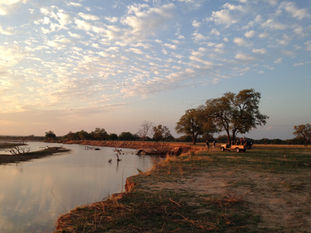
Conservation Biology
Group

What if the solution to climate crisis was quietly sitting under our noses – soggy, carbon-rich, and overlooked?

Peatlands, covering just 3% of the Earth’s surface and store in astonishing 30% of global soil carbon — twice as much as all the world’s forests combined1,2. However, when drained for agriculture, these carbon-rich landscapes transform into major sources of greenhouse gas emissions, contributing to the climate crisis3. Rewetting peatlands offers a vital solution to this challenge, but the process is far from straightforward, as explored in a recent study on farmers in the Teufelsmoor region of Germany4.
Peatlands: A hidden climate ally
Draining peatlands for agriculture not only releases massive amounts of carbon dioxide but also degrades their unique biodiversity2. The Teufelsmoor region exemplifies the tension between ecological conservation and agricultural livelihoods. Covering 360 km², it contributes disproportionately to greenhouse gas emissions in Lower Saxony, accounting for a significant share of emissions from agricultural soils in the region4.
Rewetting peatlands can drastically reduce emissions—up to 30 tons of CO₂ per hectare annually. To put that into perspective, thats the equivalent to the emissions from driving 150,000 kilometers in a car. Moreover, innovative approaches like paludiculture, a type of farming adapted to wet peatlands, offer promising opportunities for sustainable land use. By cultivating water-tolerant crops like reeds, cattails and sphagnum moss, farmers can continue to genereate income while maintaining the peatsland's natural functions. However, transitioning to such practices requires addressing significant social, economic, and cultural challenges5.
Farmers at the crossroads
The study interviewed 19 farmers and identified four distinct groups based on their attitudes toward rewetting:
Pioneers: Innovators eager to embrace change and explore opportunities in rewetting and paludiculture. They see themselves as “climate farmers" but are constrained by a lack of financial and political support.
Sceptics: Traditionalists who resist rewetting due to skepticism about its effectiveness and fear of losing their livelihoods.
Pragmatists: Open to change but cautious. They demand clear policies, financial incentives, and market stability before committing to rewetting.
Hobby Farmers: Farming primarily for personal fulfillment rather than income, this group is less impacted by the economic risks of rewetting but remains detached from broader conservation efforts.
This diversity of views highlights an important point: farmers are not a monolith- any solutions need to address this spectrum of perspectives4.
Barriers to change
Rewetting sounds great on paper, but the reality is complex. Farmers in the Teufelsmoor face numerous difficulties, from the financial risks of changing farming practices to the practical challenges of managing rewetted landscapes4. Political inconsistency, inadequate infrastructure, and a lack of knowledge about peatland ecology further compound the difficulties4.
Additionally, there is a cultural disconnect. For many farmers, drained peatlands symbolize productivity and hard-earned success. Rewetting is often perceived as a return to "dead land" rather than a step toward ecological restoration5.
Towards a just transformation
Effective transformation of peatland management requires more than technical solutions—it demands a deep understanding of the social fabric of farming communities.
Key steps include:
Financial and Policy Support: Farmers need assurance of stable incomes through subsidies, carbon credit schemes, or new markets for paludiculture products.
Knowledge Sharing: Bridging the gap between scientific research and practical farming knowledge is essential. Peer learning and community-led initiatives can build trust and confidence in rewetting practices.
Shifting Narratives: Reframing peatlands as vibrant, productive landscapes is critical. Celebrating farmers as climate stewards can foster pride and motivate change.
The road ahead
The Teufelsmoor study reveals the complexity of balancing climate goals with the realities of farming livelihoods. Farmers in the region are at the forefront of a critical transition, and their decisions will have ripple effects far beyond their local community. Peatlands are not just a German issue — they are a global resource. Restoring these landscapes is an effective climate actions we can take, with benefits that extend far beyond the Teufelsmoor.
By supporting farmers with the resources, knowledge, and encouragement they need, we can create a model for sustainable peatland management that benefits both people and the planet. The transformation of peatlands is more than an ecological necessity—it’s a chance to rethink farming for a sustainable, resilient future.
References
Loisel, J., Gallego-Sala, A. V., Amesbury, M. J., Magnan, G., Anshari, G., Beilman, D. W., Benavides, J. C., Blewett, J., Camill, P., Charman, D. J., Chawchai, S., Hedgpeth, A., Kleinen, T., Korhola, A., Large, D., Mansilla, C. A., Müller, J., van Bellen, S., West, J. B., Wu, J. Expert assessment of future vulnerability of the global peatland carbon sink. Nature Climate Change 11 (2021).
Silvestri, N., Giannini, V., Dragoni, F. & Bonari, E. A Multi-Adaptive Framework for the Crop Choice in Paludicultural Cropping Systems. Italian Journal of Agronomy 12 (2017).
Hünnebeck‐Wells, A., Loos, J., Abel, S. & Nordt, A. Transformation towards the sustainable management of peatlands: A characterization of farmers in the Teufelsmoor, Germany. People and Nature (2024)
Wichmann, S. & Nordt, A. Unlocking the potential of peatlands and paludiculture to achieve Germany’s climate targets: obstacles and major fields of action. Frontiers in Climate 6, (2024).
Sommer, P. & Frank, L. Peatland rewetting as drainage exnovation – A transition governance perspective. Land use policy 143, (2024).





